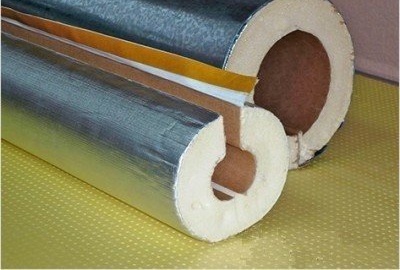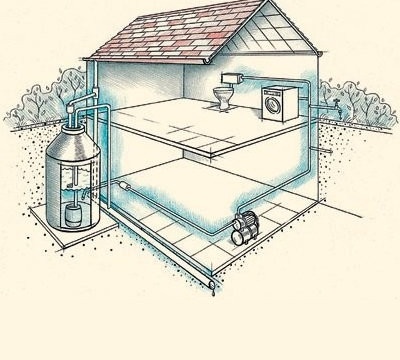Insulation of the external water supply in the ground - selection of suitable thermal insulation and its installation

Long gone are the days when residents of private homes ran year-round to wells for water. Today, even summer residents are laying water pipes on their sites, creating comfortable living conditions for themselves. Of course, if you use it only in the summer, then you can sprinkle the pipes with a little earth. Owners of suburban cottages need to make high-quality insulation of the water supply in the ground, which even in the middle lane freezes to a depth of 1.5-2 meters. As practice shows: poorly insulated pipes freeze at minus seven in just a week.
What should be insulation materials?
For the insulation of water pipes most often used:
- polystyrene (polystyrene). This is a very convenient and cheap material, the installation of which does not require any special skills. It retains all its properties underground, and can be reused, for example, if you need to disassemble the water supply;
- basalt cotton wool. Comfortable but expensive stuff. It is a basalt fiber cylinder, covered with a protective layer of roofing material, foil isol or glassine. Provides a snug fit to the pipes. Its installation does not require the use of special trays;
- fiberglass (glass wool). Cheap and easy to install material with good thermal insulation properties. It is mainly used for insulation of metal-plastic and plastic pipes.
Insulation material must have appropriate performance and meet certain standards. When buying a heater, you need to pay attention to the following parameters:
- low thermal conductivity and high heat saving;
- resistance to aggressive environmental influences;
- good water absorption;
- ability to withstand operating temperature without additional insulation.
Simplicity of installation, durability, fire safety and tightness - these are the main requirements that apply to heaters. Equally important are price and reusability. In private homes, most of the work is done by the owners on their own, so the insulation should be reliable, and its installation should be simple and convenient.
Read more about the choice of insulation for water pipes in our article:https://aquatech.tomathouse.com/en/uchebnik/truby/uteplitel-dlya-trub.html.
How to lay insulation on the water supply?
Fiberglass water pipes are usually insulated in the country. They wrap pipes, and then fasten with plastic tape. Further, with the help of roofing material or other similar materials, waterproofing is provided.
Thermal insulation shells made of foam or basalt fiber are mounted quickly and easily. Their halves are put on pipes with an offset relative to each other. This is necessary for the "overlap", which is from 10 to 20 centimeters.The halves are fastened with adhesive tape, which is glued for greater reliability. The next layer is laid protective material. For insulating corners, turns and system nodes, shaped shells are used. The diameter is selected so that the water pipe fits snugly against the insulation.
Additional protection against freezing pressure or heating cable
Everyone knows that if water is under a certain pressure, it does not freeze. This is an effective and proven method. For its implementation, it is enough to embed a small receiver into the pipe. In order for the pressure to be throughout the entire water supply (from the well to the receiver), a check valve is connected immediately after the pump. Then close the tap in front of the receiver and start the pump.
Before leaving the cottage, you need to create a pressure of three to five atmospheres. Water supply, of course, should be designed for this. So you can guarantee that it will not freeze in the winter. With the start of the season, it is enough to relieve the pumped-up pressure, and the system is ready to work in normal mode. To organize the operation of the system, it is better to use submersible pumps. They develop a pressure of five to seven atmospheres.
Outdoor insulation water supply heating cable - This is perhaps the most reliable way to protect pipes from freezing. So you can insulate the water supply both in the country house and in the cottage. Since frozen pipes (at a depth of about two meters) can thaw on their own only by mid-May, with the help of a heating cable they can be prepared for work in just one day.

The heating cable not only prevents the pipes from freezing in a private house, but also allows you to quickly defrost the water supply in the country
If you use this method, it is not necessary to deepen the water pipes by two to two and a half meters, fifty centimeters is enough. With a step of 10-15 centimeters, they are wrapped with a cable with a power of 10-12 W / m. It can be located both inside and outside the water supply.
One of the most problematic places is the area at the entrance to the wall of the building. To protect yourself from problems, it is enough to mount a few meters of heating cable into the pipe.
Now, more and more often, points of collection of temperature information are being mounted with it. It is enough to install 3-4 sensors on the track to control it manually or automatically. For example, if the temperature drops below + 5C, the system turns on a voice alert, sends a message to an e-mail or mobile phone. You can also provide for the automatic inclusion of heating at specified parameters.
Pay attention to tips for choosing water pipes:https://aquatech.tomathouse.com/en/vodosnab/document/kakie-truby-vybrat-dlya-vodosnabzheniya.html.
Secrets of proper warming are shared by experienced craftsmen
A harsh winter will not be a problem for those who did not save and did the warming of the water supply in conscience. However, even following all the rules, you may encounter unexpected problems.
They are not described in the literature, but experienced masters still advise you to remember them.
- Firstly, warm water pipes in winter become objects of increased attention from rodents (rats, moles and other animals). They easily gnaw through the insulation, as well as plastic and asbestos-cement pipes, considering them a suitable warm place. You can protect the water supply from them, either by wrapping it with a metal mesh, a plastered mortar with broken glass, or using a metal sleeve.
- Secondly, it is necessary to heat and warm all sections of the pipeline that may be at low temperatures. This also applies to premises located in the house, such as an unheated basement.
- Thirdly, if water is used to heat the water supply system from the general heating system, then it is absolutely impossible to turn off the boiler. With this method of insulation, both pipes must be in contact and be inside the thermal insulation.
- Fourth, close attention must be paid to the connecting elements. Just one drop of water, frozen in the thread, breaks them.And pipes should not be corroded. Metalloplastik is the best option.
- Fifth, be sure to draw up a detailed diagram of the underground communications on the site and in the house and save it.
It is necessary to insulate not only pipes, but also the well. Learn more about the methods and technologies in our next article:https://aquatech.tomathouse.com/en/vodosnab/kolod-skvaj/kak-uteplit-skvazhinu-na-zimu.html.
Errors made during the insulation and insulation of the water supply can turn out to be not only a big expense. It is difficult, if not impossible, to repair broken pipes in winter. Therefore, you can not save on insulation. Materials must be of high quality, from well-known manufacturers. It is better to put a heating cable, but not to use it, than to regret its absence.





